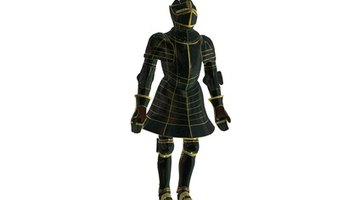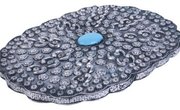A knight in armor is seen as a difficult force to overcome. However, although knights had more protection than some other fighters, such as foot soldiers, spearmen and peasants, there are still many disadvantages to wearing armor. These disadvantages sometimes outweighed the benefits that heavy armor provided. Knowing the disadvantages and advantages of armor helps us better understand how ancient battles were fought, how knights acted and what they brought to a battle.
Disadvantage: Weight
Knight armor weighed between 40 and 60 pounds usually. This was a great disadvantage in hand-to-hand combat where maneuverability was important. A knight heading off to battle could be worn out before he even got to the battle field, which is why knights usually rode on horses. Once they arrived they arrived knights usually switched to fighting on foot.
Disadvantage: Maneuverability
The maneuverability of a suit of armor is relatively limited. The armor joints were stiff and difficult to move. Most suits of armor were bulky, which gave the knight a smaller range of motion. This made it difficult to engage in quick combat. Maneuverability is mostly a disadvantage, but some knights were able to maneuver better than others.
Disadvantage: Breathability and Vision
A knight’s helmet was a large piece of metal designed to cover his entire head. Usually small eye and mouth holes were cut into the helmet, which left little room to see and let in little air to breathe. This was a great disadvantage in battle. To see properly, a knight would have to remove the face visor or the entire helmet, which made him a target for hits to the face. The lack of breathability in the helmet also made it difficult to catch enough air for tough combat.
Disdvantage: Heat
A knight’s armor was made of metal. To prevent injury to the body a knight would wear chainmail (a suit of metal circles linked together) under the armor and a suit of quilted padding under the chainmail. Because this contained so many layers, the suit got hot very quickly and remained heated throughout battle. This increased the chances for heat exhaustion and dehydration. This is an extreme disadvantage for knights fighting in battle.
Advantage: Protection
The main advantage to a knight’s armor was the protection that it provided. If a knight's opponent did not aim for the right places on the armor (such as the armpits and neck), then it was nearly impossible to damage the knight. This was a huge advantage in hand-to-hand combat. Armor was also able to block the earliest form of guns brought into battle. Even with all of the disadvantages, a knight in armor was still a powerful force on the battle field, lasting much longer than anyone without armor.
Advantage: Identification
A knight also wore armor as a status symbol, distinguishing him from peasant soldiers. There were few knights in each province or region which made it easy to identify a specific knight. Knights also customized their armor with their family's crest. This was a benefit to those fighting with a knight because it was used as a rallying point. The identity of the knight kept the rest of the army fighting together as a unit.
Related Articles
References
Writer Bio
Brenda Priddy has more than 10 years of crafting and design experience, as well as more than six years of professional writing experience. Her work appears in online publications such as Donna Rae at Home, Five Minutes for Going Green and Daily Mayo. Priddy also writes for Archstone Business Solutions and holds an Associate of Arts in English from McLennan Community College.











